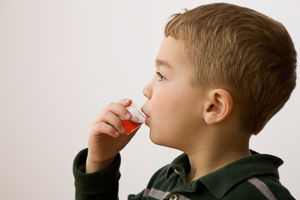Acetaminophen Use in Young Children
Topic Overview

Acetaminophen, such as Tylenol, helps reduce fever and relieve pain. It does not reduce inflammation, as do nonsteroidal anti-inflammatory drugs (NSAIDs) such as ibuprofen, but it also is less likely to cause stomach upset and other side effects.
Be sure to follow these medicine precautions.
- Acetaminophen can be found in many forms and comes in different doses.
- Be safe with medicines. Read and follow all instructions on the label.
- Do not give your child more than the maximum dose recommended on the label.
- Be careful when giving your child over-the-counter cold or flu medicines and acetaminophen (Tylenol) at the same time. Many of these medicines already contain acetaminophen. Too much acetaminophen can be harmful.
- If you give medicine to your baby, follow your doctor's or a pharmacist's advice about what amount to give. Do not use acetaminophen if your child is allergic to it.
- Talk to your doctor or a pharmacist before you give medicine to reduce a fever in a baby who is 3 months of age or younger. This is to make sure a young baby's fever is not a sign of a serious illness. Sometimes a fever occurs after an immunization. Follow your doctor's or a pharmacist's instructions for treating your baby's fever after an immunization.
- Acetaminophen products include chewable tablets, syrup, and rectal suppositories. The correct dose and timing of the dose are important for the medicine to work well. Always read the label so that you give the right dose based on your child's age and/or weight. Infants usually need a different dose than children do. Use the measuring tool that comes with the medicine, not a household spoon, to be sure to measure and give the right dose.
- Acetaminophen and ibuprofen are different products with different dosing recommendations. Talk to your child's doctor or a pharmacist before switching back and forth between doses of acetaminophen and ibuprofen. When you switch between two medicines, there is a chance your child will get too much medicine.
Dosage:Give acetaminophen every 4 hours as needed. Do not give more than 5 doses in a 24-hour period. Dosages are based on the child's weight regardless of whether oral or rectal products are used.
Caution: Do not use this dose table with any other concentration of this medicine. Use only with the concentration of 160 mg in 5 mL. Check the label on your medicine to find the concentration.
|
Child's weight in pounds (lbs) |
Child's weight in kilograms (kg) |
Dose in milligrams (mg) |
Dose in milliliters (mL) |
|---|---|---|---|
|
less than 11.0 |
less than 5.4 |
Ask a doctor or a pharmacist |
Ask a doctor or a pharmacist |
|
12.0-17.0 |
5.5-7.9 |
80 mg |
2.5 mL |
|
18.0-23.0 |
8.0-10.9 |
120 mg |
3.75 mL |
|
24.0-35.0 |
11.0-15.9 |
160 mg |
5 mL |
|
36.0-47.0 |
16.0-21.9 |
240 mg |
7.5 mL |
|
48.0-59.0 |
22.0-26.9 |
320 mg |
10 mL |
|
60.0-71.0 |
27.0-31.9 |
400 mg |
12.5 mL |
|
72.0-95.0 |
32.0-43.9 |
480 mg |
15 mL |
Side effects of acetaminophen are rare.
- Nausea and rash are the most common.
- High doses of acetaminophen can contribute to liver and kidney damage.
Do not give your child acetaminophen if he or she has liver disease.
Related Information
- Respiratory Problems, Age 11 and Younger
- Head Injury, Age 3 and Younger
- Ear Problems and Injuries, Age 11 and Younger
- Fever or Chills, Age 11 and Younger
- Ear Infections
- Circumcision
- Crying, Age 3 and Younger
- Nonprescription Medicines and Products
- Hip Problems, Age 11 and Younger
- Acetaminophen Use in Young Children
- Chickenpox (Varicella)
- Headaches
- Rash, Age 11 and Younger
- Respiratory Syncytial Virus (RSV) Infection
- Fifth Disease
- Teething
- Hip Injuries, Age 11 and Younger
Credits
ByHealthwise Staff
Primary Medical Reviewer William H. Blahd, Jr., MD, FACEP - Emergency Medicine
John Pope, MD, MPH - Pediatrics
Kathleen Romito, MD - Family Medicine
Adam Husney, MD - Family Medicine
Current as ofNovember 20, 2017
- Top of Page
Next Section:
Related Information
Previous Section:
Topic Overview- Top of Page
Next Section:
Credits
Previous Section:
Related Information- Top of Page
Current as of: November 20, 2017